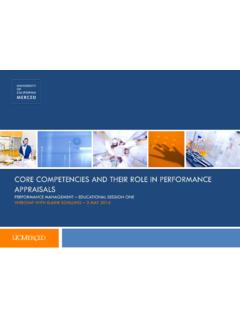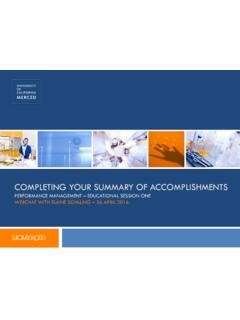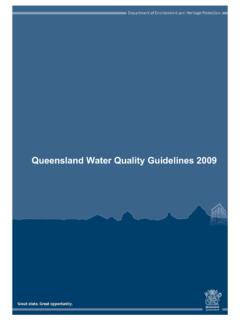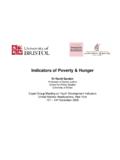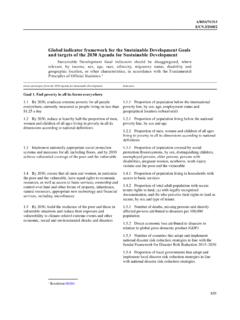Transcription of Core Competencies and Behavioral Indicators
1 Core Competencies and Behavioral Indicators COMMUNICATION. Shares and receives information using clear oral, written and interpersonal communication skills. 1. Demonstrates effective written and oral communication skills. 2. Actively listens, provides constructive feedback, and demonstrates respect for differing views. 3. Shares information with others. 4. Actively seeks others' perspectives to ensure inclusiveness and understanding. 5. Tailors communications to diverse audiences. UNACCEPTABLE PARTIALLY MEETS/NEEDS IMPROVEMENT MEETS EXPECTATIONS FAR EXCEEDS EXPECTATIONS. Reports and other documents are Written and oral skills need development. Written and verbal Communication is of the highest caliber;. 1 poorly written unclear, overly Writes and speaks clearly; however often communications are consistently clear, persuasive, accurate, and focused on simplistic, or grammatically disorganized and/or not appropriate for clear, persuasive, and audience- the needs of specific individuals and groups.
2 Incorrect. audience. appropriate. Often appears distracted or Interrupts others to express point of view; Effective communicator: Highly proficient communicator; listens to 2 disinterested; frequently interrupts has difficulty getting to the point; facts not knowledgeable and concise; and synthesizes others' ideas; explains others; contributions are often always accurate or relevant. Sometimes demonstrates active listening, even complex issues clearly and unclear or inaccurate appears inattentive. explains. succinctly. Models actively listening. Does not share information in a Tends to hold on' to information; has Consistently shares accurate, timely Models openness and transparency in 3 timely manner, creating problems for difficulty distinguishing between critical information with the right people in sharing information with campus partners colleagues and customers.
3 And noncritical data. the right format. and stakeholders. Avoids contact with coworkers Keeps communication to a minimum; Maintains open, honest dialogue To ensure optimal results, consistently 4 and campus partners. reticent to share thoughts and ideas. with coworkers and campus and effectively seeks and incorporates partners. Integrates others' others' ideas. thoughts and ideas. Has difficulty tailoring Communications do not always keep Effectively tailors Effectively adapts written and verbal 5 communication to the needs of audience; doesn't edit speech and communication to audience communication to audience; effectively others; communicates too much,' writing for greater clarity and better and individual needs. distinguishes between need to know' and too little,' or too late.' understanding. nice to know.'. Version 8/2015.
4 Core Competencies and Behavioral Indicators DIVERSITY AND INCLUSION. Models and promotes the UCM's Principles of Community and complies with UC Policies on Diversity and Non-Discrimination. 1. Demonstrates behaviors that include fairness, respect, inclusiveness, empathy, integrity, and ethical conduct. 2. Fosters a climate and culture in which each person is accepted and has the opportunity to grow and develop. 3. Practices behaviors that promote diversity and inclusion in dealings with and on behalf of the University, consistent with laws, regulations, UC Policies and Principles of Community. UNACCEPTABLE PARTIALLY MEETS/NEEDS IMPROVEMENT MEETS EXPECTATIONS FAR EXCEEDS EXPECTATIONS. Does not demonstrate inclusiveness; Is often not aware of or interested Respects, includes, and Highly inclusive; encourages, 1 fails to recognize the value of in diverse backgrounds or points of recognizes differences.
5 Recognizes and incorporates differences. view. diverse points of view. Is not welcoming or respectful; Is reticent to include new people or ideas. Includes and welcomes diverse Actively creates an inclusive and 2 coworkers and campus partners often individuals and groups. welcoming environment for diverse work around' to avoid interaction. individuals and groups across campus. Neither understands nor promotes Needs to develop better understanding Participates in range of Actively creates opportunities for 3 opportunities to experience and awareness of opportunities to opportunities to learn about and others to learn about and diversity on campus. learn about and experience diversity experience diversity on campus; experience diversity on campus. on campus. encourages others to do the same. Version 8/2015. Core Competencies and Behavioral Indicators EMPLOYEE ENGAGEMENT.
6 Demonstrates commitment to the job, colleagues, the University and its mission by acting in ways that further the accomplishment of its goals. 1. Holds self and others accountable for meeting commitments. 2. Creates and supports a climate in which people can do their best. 3. Adds value; high quality work. 4. Understands and supports organizational goals. UNACCEPTABLE PARTIALLY MEETS/NEEDS IMPROVEMENT MEETS EXPECTATIONS FAR EXCEEDS EXPECTATIONS. Does not take ownership and often Often does not take ownership and is Exhibits self-accountability and Consistently exhibits self-accountability and 1 blames others for not being able to deficient in encouraging others to acknowledges the support and actively seeks to acknowledge contributions. make commitments. achieve goals. contributions of others. Inspires others to do the same.
7 Hinders sharing of knowledge Does not openly share expertise Consistently and actively assists others Inspires and helps others develop skills and 2 and/or expertise; focused largely or information with others. in expanding and developing skills and Competencies to perform at their best; is on own development. knowledge. highly respected among peers and campus partners. Does not add value in terms of Contributions are often lacking in Effectively contributes to team efforts; Contributions consistently add value: 3 contributing to team and substance and practicality; output work is professional and high quality . output is consistently professional, department goals; work is poor in either overly simplistic or difficult to practical, and of the highest caliber. quality and lacking in substance. understand. Resistant to change; maintains focus Contributions and work efforts often Demonstrates understanding of; and Consistently encourages and leads changes that 4 on immediate, routine tasks; work do not reflect an understanding of unit supports the need to align work with enhance organizational and workforce efforts do not align with unit and and department goals.
8 Organizational initiatives and goals. effectiveness. department goals. Version 8/2015. Core Competencies and Behavioral Indicators INNOVATION AND CHANGE MANAGEMENT. Uses personal knowledge and professional experience to envision the future, anticipate change, capitalize on opportunities and develop innovative options that further the strategic direction of the organization. 1. Understands and adapts to changes in the strategic and/or operational direction of the organization 2. Shows foresight and imagination to see possibilities, opportunities and trends 3. Demonstrates commitment to seek out opportunities and contributes to developing innovative or alternative solutions. 4. Understands the strategic direction and goals of the organization and aligns personal performance objectives with organizational priorities. UNACCEPTABLE PARTIALLY MEETS/NEEDS IMPROVEMENT MEETS EXPECTATIONS FAR EXCEEDS EXPECTATIONS.
9 Fails to alter usual patterns of Has difficulty accepting and Actively supports changing Anticipates and proactively responds to 1 behavior or performance to cooperating in the implementation direction, goals and changing situations. Is consistently adapt to operational changes. Is of change, responsibilities. Is flexible, receptive to new ideas and information. not receptive to new viewpoints open and receptive to new Inspires, encourages and provides or directions. information and ideas. support to others in response to change. Does not show foresight and Inconsistently demonstrates foresight Demonstrates foresight and Consistently demonstrates foresight and 2 imagination to see possibilities, and imagination to see possibilities, imagination to see possibilities, proactively seeks opportunities to expand opportunities and trends.
10 Opportunities and trends opportunities and trends knowledge of innovative solutions and ideas. Resists opportunities and Often does not demonstrate a Frequently identifies Consistently demonstrates creative 3 challenges, does not show commitment to seek out opportunities in challenges behavior and makes significant initiative to develop opportunities to innovate. Shows and demonstrates initiative to contributions to developing innovative innovative solutions. little initiative. develop alternative solutions. solutions. Is unaware of organizational Is often unaware of organizational Regularly demonstrates Thoroughly aware of organizational goals 4 goals and fails to change usual goals; demonstrates resistance in awareness of organizational and strategic direction. Switches roles and patterns of behavior or adjusting to changing situations, goals; modifies one's preferred procedures easily to facilitate change in line performance in alignment with priorities and responsibilities.

